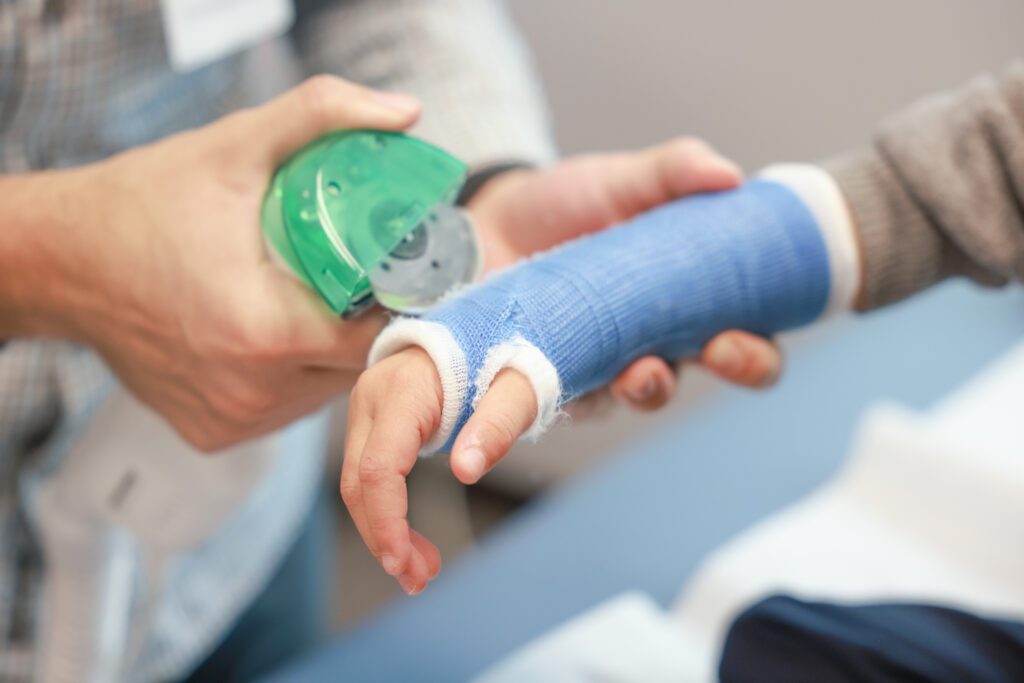At Pediatric Orthopedic Specialists, we understand that children are naturally active, often engaging in activities like running, playing, and sports. With such high-energy pursuits, the risk of falls and injuries, including fractures or bone breaks, is ever-present. Our dedicated team is specialized in the care and treatment of pediatric fractures and trauma, ensuring your child receives the best possible care for a swift and effective recovery.

Understanding Pediatric Fractures
- Common Fracture Types: In children, the most common fractures occur in the thighbone (femur), elbow, and tibia (the larger bone in the lower leg). Despite the femur being one of the strongest bones in the body, its fracture is not uncommon in active children.
- Elbow Fractures: Elbow injuries require close attention due to the complexity of the joint. Persistent pain and swelling in the elbow after an injury may indicate a fracture.
- Tibial Pseudarthrosis: This refers to a fracture in the tibia that does not heal correctly, a condition known as nonunion. It requires specialized care to ensure proper healing.
Our Approach to Care
- Prompt and Accurate Diagnosis: Early and accurate diagnosis is crucial. We recommend seeking immediate medical attention if a fracture is suspected, as prompt treatment is essential for proper bone healing.
- Specialized Treatment: Our team is equipped with the expertise and technology to handle various types of pediatric fractures. We provide personalized care tailored to the specific needs of each child, ensuring the best possible outcome.
- Focus on Healing and Recovery: Our goal is not only to treat the fracture but also to support your child’s overall well-being and return to their normal activities as quickly and safely as possible.
Commitment to Excellence
At Pediatric Orthopedic Specialists, we are committed to providing comprehensive, compassionate care for children experiencing fractures and trauma. Our team, equipped with the latest knowledge and techniques in pediatric orthopedics, ensures that your child receives the highest standard of care. We work closely with families to keep you informed and involved in your child’s care every step of the way.
Areas of Expertise
- Fractures & Trauma
- Abnormal Gait/Limping
- Developmental Disorders
- Leg Length Discrepancy
- Knock-knees & Bow-legs
- Metabolic Disorders
- Genetic & Congenital Disorders
- Toe-Walking
- Clubfoot
- Developmental Dysplasia of the Hip (DDH)
- Slipped Capital Femoral Epiphysis (SCFE)
- Legg-Calve-Perthes (Perthes)
- In-Toeing & Out-Toeing
- Accessory Navicular
- Syndactyly & Polydactyly of Toes
- Osteogenesis Imperfecta

As a parent, I understand the anxiety and concern that comes with your child’s health issues. At Pediatric Orthopedic Specialists, we are deeply committed to transparency in all aspects of our care. This approach is central to helping you feel at ease during what can be a challenging time. Rest assured, your child’s health is our premier concern.
- Dr. John Smith, Pediatric Orthopedic Surgeon
For more information or to schedule an appointment, please contact our office. We are here to support your child’s journey to healing and recovery.
FAQ’s
How can I tell if my child has a fracture and what should I do immediately after the injury?
It’s crucial to be aware of signs like severe pain, swelling, or an inability to move the injured area, as these may indicate a fracture. If you suspect a fracture, keep the injured area immobilized and seek medical attention immediately. Rest assured, our team is here to provide prompt and compassionate care to accurately diagnose and treat your child’s injury.
What is the typical treatment process for fractures in children?
The treatment varies depending on the fracture’s type and location. Common methods include casting, splinting, or in some cases, surgery. Our primary goal is to ensure the bone heals correctly while minimizing discomfort. We personalize each treatment plan to suit the specific needs of your child, ensuring the best possible outcome with the least disruption to their daily life.
How long does it take for a pediatric fracture to heal, and will it affect my child's growth?
Children’s bones generally heal faster than adults. The healing time can range from a few weeks to a few months, depending on the fracture’s severity and the child’s age. Most pediatric fractures heal without affecting future growth or development. Our team closely monitors the healing process to ensure optimal recovery.
What kind of rehabilitation or follow-up care is required after the fracture heals?
Rehabilitation plays a vital role in full recovery. It may include physical therapy to restore strength, flexibility, and range of motion. We’ll guide you through the rehabilitation process, tailoring it to your child’s specific needs. Follow-up visits are also important to ensure the bone has healed correctly and to prevent any long-term complications.
How can I help my child prevent future fractures or injuries?
Prevention is key in pediatric care. Encourage safe playing practices, use appropriate safety gear for sports, and ensure your home environment minimizes the risk of falls. We’re here to offer guidance on injury prevention and to support your child in leading a healthy, active lifestyle.

